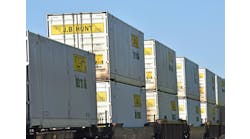We write here all the time about specific challenges logistics and supply chain professionals come up against in their daily jobs, whether it’s rising fuel costs, demand forecasts, raw materials shortages, on-time deliveries, weather delays, or any number of other situations that require your attention. But how would you react if your local airport wasn’t just closed down for a day due to inclement weather, but indefinitely? How would you deal with inbound and outbound logistics if the one major seaport in your supply chain was utterly destroyed? How would you cope with a catastrophe that took the lives of more than 100,000 people?
Those are the types of challenges confronting logistics experts trying to deliver emergency assistance and supplies to the island nation of Haiti, which was pummeled by a 7.0 magnitude earthquake on January 12, and then hit with a 5.9 aftershock a week later. The quake destroyed much of the country’s logistics infrastructure, in particular roads, seaports and airports, which made rescue efforts not only extremely difficult but hazardous as well. Amidst the usual finger-pointing and political posturing about how long it was taking to deliver aid to Haiti, a clearer picture was emerging: Although Haiti had been utterly incapacitated, rescue efforts were performing at the highest levels in circumstances that made even the mere act of entering a building a risky venture.
The response from the logistics industry has been nothing short of fabulous, although it’s almost reached the point that we take for granted that supply chain professionals will be front and center whenever a call for help goes out. The big three package delivery companies—DHL, FedEx and UPS—began mobilizing their relief efforts as soon as news of the earthquake’s devastation spread worldwide, just as they and hundreds of other logistics companies large and small had similarly responded to previous natural disasters, from hurricanes to tsunamis to floods to other earthquakes.
In addition, Aidmatrix is coordinating relief efforts, as to date Project HOPE, ISTAT’s (International Society of Transport Aircraft Trading) Airlink program, ALAN (American Logistics Aid Network), MedShare, Adventist Community Services (ACS), Powered by ACTION, the State of Florida and the Government of Puerto Rico’s Departamento de la Familia have activated their portals or joined other installations on the Aidmatrix Network.
Aidmatrix, which has its roots in technology created by supply chain management software pioneer i2 Technology, is an online community of nonprofits, governments and donors that work together on humanitarian crises. The network links all of these organizations into a web portal with the goal of helping to manage the donation, purchasing, tracking, warehousing, transportation and distribution of products and services for use in humanitarian relief. To participate in the relief efforts, go to www.aidmatrix.org/haiti.
This article originally appeared in the Logistics Today digital magazine. To read other articles from that issue, click here: http://penton.ebookhost.net/lt/ebook/13/



